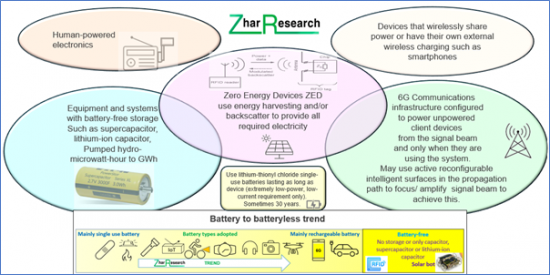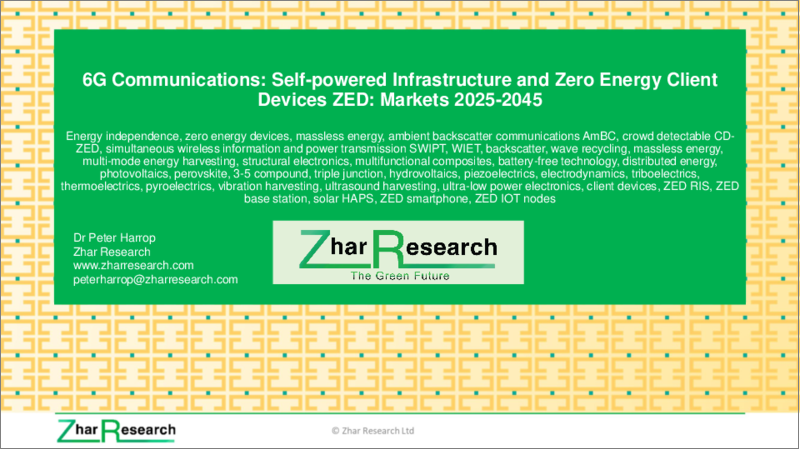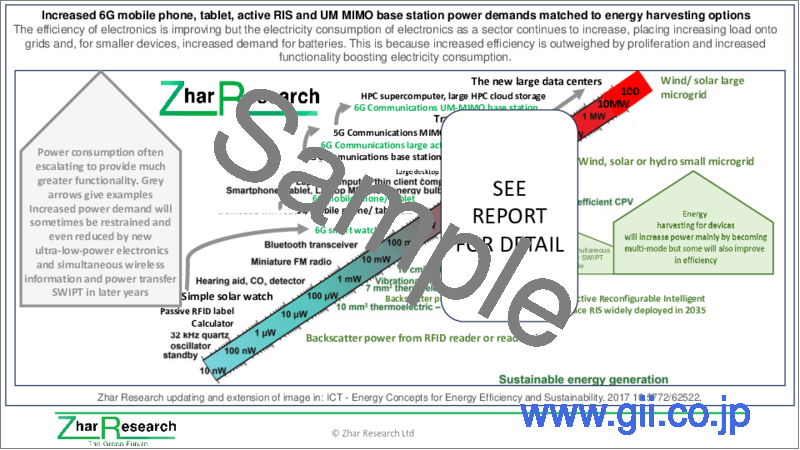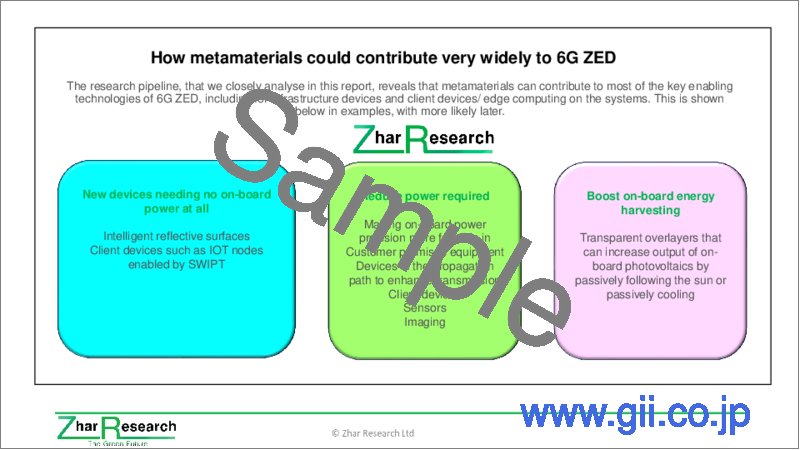|
|
市場調査レポート
商品コード
1533184
6G通信:自家発電インフラおよびクライアントZED (ゼロエネルギーデバイス) 市場 (2025-2045年)6G Communications: Self-powered Infrastructure and Zero Energy Client Devices ZED: Markets 2025-2045 |
||||||
|
|||||||
| 6G通信:自家発電インフラおよびクライアントZED (ゼロエネルギーデバイス) 市場 (2025-2045年) |
|
出版日: 2024年08月13日
発行: Zhar Research
ページ情報: 英文 397 Pages
納期: 即日から翌営業日
|
全表示
- 概要
- 目次
必要とされるどんな場所でも優れた性能を発揮できる通信であることが、6G通信の成功に不可欠です。
自家発電でほぼどこでも動作
基地局、顧客構内設備、そして新たに不可欠となったRISなどの、微弱な高周波を目的地まで届けるための工事は不要となり、有線接続や充電器を必要とするクライアントデバイスもなくなるでしょう。一方、太陽光だけで成層圏を何年も飛行するソーラードローン「空の塔」のような、自己発電型のインフラが登場するでしょう。効率40%の太陽光発電とその他のハーベスティング技術で自己発電する6Gクライアントデバイスを考えてみましょう。必要なときに信号で駆動する電池不要のクライアントデバイスを追加し、据付けしたあとは忘れてしまえる喜びを味わいましょう。

当レポートでは、6G通信の自家発電インフラおよびクライアントZED (ゼロエネルギーデバイス) の市場を調査し、6G ZEDインフラとクライアントデバイスの実現技術の概要、新しい機会、技術ロードマップ、市場規模の推移・予測、主要企業の取り組みなどをまとめています。
当レポートでは、106社以上を取り上げ、約1,000種の最新の研究論文や企業の取り組みを抽出し、107のインフォグラム、表、グラフで、10種のSWOT評価、14種の予測ライン (2025-2045年) をまとめています。
目次
第1章 エグゼクティブサマリー・総論
- 目的・範囲
- 調査手法
- 20の主な結論
- ZEDのコンテキスト:重複および隣接技術と長寿命のエネルギー独立型デバイスの例
- 主要な6Gインフラとクライアントデバイスがゼロエネルギー、電池フリー、長寿命化を実現
- 電池不要の6G ZEDを実現する主な技術
- 組み合わせ可能な8つのオプション
- 6G通信におけるZEDの重要性
- 6G ZEDと実現技術のロードマップ
- 市場予測
第2章 イントロダクション
- 概要
- 6Gの基礎
- 6Gフェーズ1と2におけるZEDのニーズと機会
- 6G ZEDに関連するその他の資料
第3章 6G ZEDインフラとクライアントデバイスの実現技術:メタマテリアル、IRS、RIS、構造エレクトロニクス
- ゼロおよび低電力のインテリジェントサーフェスとソーラー強化を提供することで6G ZEDを可能にするメタマテリアルとメタサーフェス
- メタマテリアル、IRS、RISの概要
- 例:5Gおよび6G向けのメタマテリアルIRS ZEDのウィンドウ
- メタマテリアルツールキットの主な例、6つのフォーマット、6G ZEDの関連性
- メタ原子材料、デザイン、パターン形成のオプション
- 6G利用に向けた商業的、運用的、理論的、構造的オプションの進化
- 6G RISサブTHz、THz、光学バージョンに適合したメタマテリアル製造技術
- 再構成可能インテリジェントサーフェスおよびその他の目的のためのメタサーフェス
- 6G IRSとRISで使用される主な材料
- 6G RISの構成と動作
- 6G RIS向け8つのチューニングデバイスファミリーとその材料要件
- ディスクリートボード、積層フィルムからフルスマート材料の統合、構造エレクトロニクスまでのトレンド
- 6G ZEDに役立つメタサーフェスエネルギー回収の強化
- メタマテリアルベースの6G ZED技術の3つのSWOT評価
- メタマテリアルとメタサーフェス全般のSWOT評価
- ZEDバージョンを含む将来の6G RIS設計を導くSWOT評価
- 6G通信IRSおよびRISの機会のSWOT評価
第4章 6G ZEDの実現技術:SWIPT、AmBC、CD-ZED
- 概要:6G ZEDを実現する後方拡散とSWIPT
- ハイブリッドビームフォーミングベースのSWIPT
- AmBCとCD-ZED
第5章 6G ZEDの実現技術:6Gインフラとクライアントデバイスのエネルギー回収
- 概要:変化するニーズと13の技術
- ZEDで検討されている13種類のエネルギー回収技術
- 電磁放射の回収:太陽光発電、周囲RF
- 機械的放出の回収:超低周波音、音響、振動、電気力学、圧電、摩擦電気、その他の技術
- 熱電、焦電、水力、バイオ燃料電池などのオプション
- 概要
- 熱電
- 焦電型
- 熱水力発電
- バイオ燃料電池
- その他のオプション
第6章 6G ZEDの実現性を高める超低電力エレクトロニクスと電気
- 概要
- システムレベルの省エネ
- コンポーネントレベルの省エネ:超低消費電力集積回路、低消費電力ディスプレイなど
第7章 電池不要6G ZEDのための電池の排除・スーパーキャパシタ・バリアント・質量ゼロエネルギー
- 概要
- 選択範囲- コンデンサからスーパーキャパシタ、電池まで
- リチウムイオンコンデンサの特徴
- スーパーキャパシタとその派生製品の実際および潜在的な用途
- ZED向け電池不要ストレージ技術のSWOT評価
- スーパーキャパシタとそのバリエーションにより実現されるZEDの例
- 質量ゼロのエネルギースーパーキャパシタ構造エレクトロニクス
- 研究パイプライン:スーパーキャパシタ
- 研究パイプライン:ハイブリッドアプローチ
- 研究パイプライン:擬似キャパシタ
Essential to success of 6G Communications will be it working with superior performance almost anywhere you need it. The new 397-page, commercially-oriented report, "6G Communications: Self-powered Infrastructure and Zero Energy Client Devices ZED: Markets 2025-2045" reveals huge opportunities in a relatively neglected yet essential key enabling technology.
Self-powered, working almost everywhere
Gone will be earthworks to base stations, customer premises equipment and those newly-essential reconfigurable intelligent surfaces RIS everywhere to get the feeble higher frequency emissions to destination. Gone will be client devices hard-wired or in need of chargers. Welcome self-powered infrastructure such as the solar drone "tower in the sky" aloft for years in the stratosphere on sunshine alone. Think self-powered 6G client devices with 40% efficient photovoltaics and other harvesting. Add battery-free client devices powered by signal when needed and delights of fit-and-forget.
Uniquely up-to-date and insightful
This PhD level analysis has 7 Chapters, 10 SWOT appraisals, 14 Forecast lines 2025-2045, over 106 companies mentioned, 107 infograms, tables, graphs distilling about 1000 latest research papers and company initiatives.
It assists those entering the value chain of 6G Zero Energy Devices ZED. Useful to investors, materials and device suppliers and system integrators seeking to pull ahead, it provides insightful PhD level analysis of the latest research, heavily biassed towards 2024 announcements. It is constantly updated so you only get the latest. Absorb new industrial initiatives, research advances and expert opinions.
The forecasts presume that 6G will succeed but the analysis is balanced, detailing pros and cons. Topics covered extend well beyond electronic and electrical equipment and devices that make all their electricity with on-board ambient energy harvesting, increasingly multi-mode. Understand simultaneous wireless information and power transfer SWIPT enabling devices to power up when needed from the signal beam and even research on harvesting electricity from the signal. See electronic devices that need no power such as 6G passive metamaterial reflect-array surfaces you can supply.
The report analyses enabling technologies arriving such as ultra-low power electronics and metasurfaces needing only a whisper of electricity, transparent and battery-free technology all leading to the new world of very-long-life, fit-and-forget 6G devices and infrastructure often vanishing into the fabric of society.
Questions answered include:
- How can I create a $1 billion 6G ZED business?
- Potential competitors, partners or acquisitions?
- Market and technology roadmap for 2025-2045?
- Technology readiness and potential improvement?
- Appraisal of needs and appropriate technology options?
- Market drivers and forecasts of background parameters?
- Market forecasts by technology and application 2025-2044?
- Deep analysis of research pipeline including 2024 with implications?
- Explanation of trend to "massless energy", and other structural electronics?
- Battery-free, ultra-low power electronics, non-toxic, non-flammable options emerging?
The Executive Summary and Conclusions (41 slides) compresses it all into visuals, roadmaps and forecasts. The Introduction (54 slides) gives 6G justification, basics, disruptive aspects, challenges and arguments against. However, mostly it outlines ZED needs and opportunities in 6G Phase 1 and 2, examples including wireless powered IoE for 6G, zero-energy device networks with wireless-powered RIS and ZED Machine Type Communications MTC. Learn zero-energy air interface for advanced 5G and for 6G and the first real-time backscatter communication demonstrated for 6G. See further reading from 2024 and 2023 research.
Chapter 3. "6G ZED infrastructure and client device enabling technology: metamaterials, IRS, RIS, structural electronics" uses 34 pages including six SWOT appraisals to cover these basics. They include passive metamaterial reflect-arrays that need no power and semi-passive RIS needing almost no power - easily made ZED.
One route to energy independence is greatly advancing the backscatter principle of the world's most numerous electronic devices - battery-free RFID and anti-theft tags. Chapter 4. "6G ZED enabling technology: Simultaneous wireless and information transfer SWIPT, Ambient backscatter communications technology AmBC, crowd-detectable zero energy devices CD-ZED" (24 pages) addresses this and allied matters.
The largest chapter concerns the most prevalent ZED technology likely for 6G infrastructure and client devices which is reinvented on-board energy harvesting, far more powerful than we know today. The 142-page Chapter 5. "6G ZED enabling technology: energy harvesting for 6G infrastructure and client devices" makes sense of the flood of research advances particularly in 2024 and latest trials such as HAPS drones aloft on thin-film triple junction photovoltaics alone. Expect up to four energy harvesting technologies in a given device, chosen from 13 candidate harvesting families appraised, together very lightweight, low volume, low cost and producing ten to one hundred times the power. Appropriately, 49 pages are on next photovoltaics - research, demonstrations, company trends. With one micron-thick and even spray-on photovoltaics in prospect, the doubling of efficiency to around 40% will be dwarfed by PV area increasing at least ten times as it appears on all surface shapes and locations. There is good coverage of solar drones including two very significant demonstrations of low-level ones in 2024. Once again, there are dense infograms and extensive further reading, particularly from 2024.
Chapter 6 (28 pages) covers, "Ultra-low power electronics and electrics to make 6G ZED more feasible". Chapter 7 ends the report with other enabling technology for ZED infrastructure and client devices, notably making them very long-life as well. "Battery elimination, supercapacitors, variants and massless energy for battery-free 6G ZED" includes the remarkable work on potentially replacing dumb load bearing structure such as your device case or telecom tower with smart material taking similar volume, weight and cost - so called massless energy where the same structure both harvests and stores energy - transformative for 6G.
"6G Communications: Self-powered Infrastructure and Zero Energy Client Devices ZED: Markets 2025-2045" is your unique guide to supplying and using these technologies essential to 6G success.
CAPTION Context of very long life, self-powered 6G infrastructure and devices essential to success. Source, Zhar Research report, "6G Communications: Self-powered Infrastructure and Zero Energy Client Devices ZED: Markets 2025-2045"

Table of Contents
1. Executive summary and conclusions
- 1.1. Purpose and scope of this report
- 1.2. Methodology of this analysis
- 1.3 20 Primary conclusions
- 1.3.1. 6G and the place of 6G ZED
- 1.3.2. Definition of ZED and 6G ZED timing
- 1.3.3. 6G ZED enabling technologies
- 1.4. Context of ZED: overlapping and adjacent technologies and examples of long-life energy independent devices
- 1.5. Primary 6G infrastructure and client devices becoming zero-energy and battery-free, longer life
- 1.6. Primary enabling technologies for battery-free 6G ZED
- 1.6.1. Device architecture
- 1.6.2. Device battery-free storage: supercapacitors, LIC, "massless energy"
- 1.6.3. Smart materials: metamaterials, self-healing materials, structural electronics
- 1.6.4. System: SWIPT, AmBC, CD-ZED, battery elimination, other
- 1.6.5. 13 families of energy harvesting technology considered for ZED 2025-2045
- 1.7. Eight options that can be combined
- 1.8. Significance of Zero Energy Devices ZED in 6G Communications
- 1.9. Roadmap of 6G ZED and its enabling technologies 2025-2045
- 1.10. Market forecasts 2025-2045
- 1.10.1. High volume ZED devices: 6G ZED IOT and compared to RFID, EAS units billion 2025-2045
- 1.10.2. 6G backscatter SWIPT ZED client devices $ billion compared to RFID, EAS, 2025-2045
- 1.10.3. 6G fully passive metamaterial reflect-array market $ billion 2029-2045
- 1.10.4. Smartphone billion units sold globally 2024-2045 if 6G is successful
- 1.10.5. Market for 6G base stations market value $bn if successful 2025-2045
- 1.10.6. Global metamaterial and metasurface market billion square meters 2025-2045
2. Introduction
- 2.1. Overview
- 2.2. 6G basics
- 2.2.1. Background
- 2.2.2. Why do we need 6G?
- 2.2.3. Disruptive 6G aspects
- 2.2.4. Wireless powered IoE for 6G
- 2.2.5. Arguments against 6G
- 2.2.6. Challenges ahead: cost, runaway electricity consumption and frequency
- 2.2.7. SWOT appraisal of 6G Communications as currently understood
- 2.3. ZED needs and opportunities in 6G Phase 1 and 2
- 2.3.1. Background
- 2.3.2. Specific ZED needs in 6G communications
- 2.3.3. 3GPP and Kristiaanstad University vision of options for 6G ZED and wireless powered IoE for 6G
- 2.3.4. Zero-Energy Device Networks With Wireless-Powered RIS
- 2.3.5. ZED Machine Type Communications MTC
- 2.3.7. Other ZED empowered 6G opportunities
- 2.3.6. Zero-energy air interface for advanced 5G and for 6G
- 2.3.7. Other ZED empowered 6G opportunities
- 2.3.8. First real-time backscatter communication demonstrated for 6G in 2023
- 2.4. Further reading relevant to 6G ZED 2024 and 2023
3. 6G ZED infrastructure and client device enabling technology: metamaterials, IRS, RIS, structural electronics
- 3.1. Metamaterials and metasurfaces enabling 6G ZED by providing zero and low power intelligent surfaces and solar enhancement
- 3.1.1. Overview of metamaterials, IRS and RIS
- 3.1.2. Example: Metamaterial IRS ZED window for 5G then 6G
- 3.1.3. Metamaterial toolkit primary examples, six formats and 6G ZED relevance
- 3.1.4. The meta-atom materials, design and patterning options
- 3.1.5. Commercial, operational, theoretical, structural options evolving for 6G use
- 3.1.6. Metamaterial manufacturing technologies matched to 6G RIS sub-THz, THz and optical versions
- 3.1.7. Metasurfaces for reconfigurable intelligent surfaces and other purposes
- 3.1.8. Primary materials used in 6G IRS and RIS
- 3.1.9. How a 6G RIS is constructed and how it operates
- 3.1.10 8 tuning device families for 6G RIS and their materials requirements
- 3.1.11. Trend from discrete boards, stacked films to full smart material integration, structural electronics
- 3.1.12. Metasurface energy harvesting enhancement useful for 6G ZED
- 3.2. Three SWOT appraisals of metamaterial-based 6G ZED technologies
- 3.2.1. SWOT appraisal for metamaterials and metasurfaces generally
- 3.2.2. SWOT appraisal that must guide future 6G RIS design including ZED versions
- 3.2.3. SWOT appraisal of 6G Communications IRS and RIS opportunities
4. 6G ZED enabling technology: Simultaneous wireless and information transfer SWIPT, Ambient backscatter communications AmBC, crowd-detectable zero energy devices CD-ZED
- 4.1. Overview: backscatter and SWIPT to enable 6G ZED
- 4.2. Hybrid beamforming-based SWIPT
- 4.3. Ambient backscatter communications AmBC and crowd detectable CD-ZED
- 4.3.1. General
- 4.3.2. Orange AmBC and CD-ZED
- 4.3.3. Battery-free AmBC: University of California San Diego
- 4.3.4. Crowd-detectable CD-ZED research
- 4.3.5. Further research from 2024 and 2023-34 selected papers
5. 6G ZED enabling technology: energy harvesting for 6G infrastructure and client devices
- 5.1. Overview: changing needs and 13 technologies
- 5.1.1. Context
- 5.1.2. The increasing electricity consumption of electronics and matching harvesting for ZED
- 5.1.3. Energy harvesting performance comparison: power per unit volume
- 5.1.4 13 families of energy harvesting technology considered for ZED 2025-2045
- 5.2. Harvesting electromagnetic emissions: photovoltaic, ambient RF
- 5.2.1. Photovoltaic: massive power increases ahead from fit-everywhere and efficiency increase
- 5.2.2. Harvesting ambient RF power for devices and communication by recycling existing emissions
- 5.3. Harvesting mechanical emissions: infrasound, acoustic, vibration, other motion using electrodynamic, piezoelectric, triboelectric, other technologies
- 5.3.1. Overview
- 5.3.2. Electrodynamic
- 5.3.3. Piezoelectric
- 5.3.4. Triboelectric
- 5.3.5. Other
- 5.4. Thermoelectric, pyroelectric, hydrovoltaic, biofuel cell and other options
- 5.4.1. Overview
- 5.4.2. Thermoelectric
- 5.4.2. Pyroelectric
- 5.4.3. Thermal hydrovoltaic
- 5.4.4. Biofuel cell
- 5.4.5. Other options
6. Ultra-low power electronics and electrics to make 6G ZED more feasible
- 6.1. Overview
- 6.2. System level energy saving
- 6.2.1. Intermittency tolerant electronics Bfree
- 6.2.2. Ultra-low-power phononic in-sensor computing
- 6.2.3. Improved energy efficiency in 6G Communications: European Commission Hexa-X Project
- 6.2.4. Static context header compression and fragmentation for ZED
- 6.2.5. Wireless sensor networks
- 6.2.6. Ultra-low power radio module and smartphone
- 6.2.7. Other energy efficient sensing, processing and new power transfer options for 6G and IOT
- 6.3. Component-level energy saving: Ultra-low power integrated circuits, low power displays and other
- 6.3.1. Overview: displays and other components
- 6.3.2. Nanopower nPZero
- 6.3.3. Everactive ultra-low power circuits for ZED IOT
- 6.3.4. 2nm chips and beyond-USA, Taiwan, China, Japan
- 6.3.5. Ericsson Research and MIT Lithionic chips
7. Battery elimination, supercapacitors, variants and massless energy for battery-free 6G ZED
- 7.1. Overview
- 7.2. Spectrum of choice-capacitor to supercapacitor to battery
- 7.3. Lithium-ion capacitor features
- 7.4. Actual and potential major applications of supercapacitors and their derivatives 2024-2044
- 7.5. SWOT appraisal of batteryless storage technologies for ZED
- 7.6. Examples of ZED enabled by supercapacitors and variants
- 7.6.1. Bicycle dynamo with supercapacitor or electrolytic capacitor
- 7.6.2. IOT ZED enabled by LIC hybrid supercapacitor
- 7.6.3. Supercapacitors in medical devices
- 7.7. Massless energy-supercapacitor structural electronics
- 7.7.1. Review
- 7.7.2. Imperial College London, Texas A&M University, University of California San Diego, 5 others
- 7.7.3. Structural supercapacitors for electronics and devices: Vanderbilt University USA
- 7.7.4. Transparent structural supercapacitors on optoelectronic devices
- 7.8. Research pipeline: Supercapacitors
- 7.9. Research pipeline: Hybrid approaches
- 7.10. Research pipeline: Pseudocapacitors





